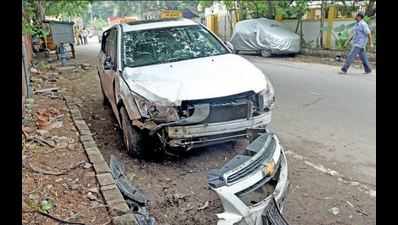- News
- City News
- chennai News
- <arttitle><sub>Audit wing to probe ‘fatal stretch</sub></arttitle>
Trending
This story is from November 13, 2017
Audit wing to probe ‘fatal stretch

In less than 14 months, two speeding cars have left two autorickshaw drivers dead and several others injured at the same spot on Dr Radhakrishnan Salai. Driving under the influence of alcohol is most likely the primary cause in both cases, but could there be a road engineering fault that may have caused the speeding vehicles to jump the pavement?
Greater Chennai Corporation said — after Sunday’s near replica of the 2016 collision — its technical audit wing will study safety on the stretch.
Planners and road experts say either a pavement extension that autorickshaw drivers use to park their vehicles or a slight curve in the carriage the ‘fatal stretch’, or both, could have b contributory factors to the accidents.
Experts said the authorities failed to conduct a comprehensive investigation of the September 2016 collision, with the city police only probing the traffic enforcement aspect of the case and the engineering department of Greater Chennai Corporation, responsible for the construction and maintenance of the roa not examining the possibility of a road d contributing to the crash.
On Sunday, Naveeth Ahmed drove into the pavement, ramming the parked autorickshaws before coming to a stop after hitting an electricity junction box. Police said it would be difficult to manoeuvre the stretch if not alert, as the two-lane road curves and widens at the spot where the autorickshaws were parked. The pavement is almost on the same level as the road, so there is nothing to break the impact. “The platform and the road should ideally be separated by installing bollards on the pavement,” said a police officer.
When asked about the maintenance of pavements, a corporation engineer said, “Fixing bollards and maintenance of pavement are being monitored by the ‘Bus Route Road’ (BRR) department of the corporation.” Earlier, each zone was assigned to lay pavements and fix bollards, but the operation was centralised some time ago and engineers at zonal offices attribute the delay in resolving issues to the change.
The State Traffic Planning Cell of the Tamil Nadu police is collecting data from across the state to map accident-prone zones. Based on the study, the cell will send a report to agencies concerned to conduct examinations for a possible engineering fault.
Greater Chennai Corporation said — after Sunday’s near replica of the 2016 collision — its technical audit wing will study safety on the stretch.
Planners and road experts say either a pavement extension that autorickshaw drivers use to park their vehicles or a slight curve in the carriage the ‘fatal stretch’, or both, could have b contributory factors to the accidents.
Experts said the authorities failed to conduct a comprehensive investigation of the September 2016 collision, with the city police only probing the traffic enforcement aspect of the case and the engineering department of Greater Chennai Corporation, responsible for the construction and maintenance of the roa not examining the possibility of a road d contributing to the crash.
A senior engineer in the corporation said RK Salai is a well-maintained stretch and was an important route till last year because VVIPs like former chief minister J Jayalalithaa used it regularly. “There is no engineering fault on RK Salai,” the official said. “The gradient [on the stretch] is such that rain does not cause waterlogging.”
On Sunday, Naveeth Ahmed drove into the pavement, ramming the parked autorickshaws before coming to a stop after hitting an electricity junction box. Police said it would be difficult to manoeuvre the stretch if not alert, as the two-lane road curves and widens at the spot where the autorickshaws were parked. The pavement is almost on the same level as the road, so there is nothing to break the impact. “The platform and the road should ideally be separated by installing bollards on the pavement,” said a police officer.
When asked about the maintenance of pavements, a corporation engineer said, “Fixing bollards and maintenance of pavement are being monitored by the ‘Bus Route Road’ (BRR) department of the corporation.” Earlier, each zone was assigned to lay pavements and fix bollards, but the operation was centralised some time ago and engineers at zonal offices attribute the delay in resolving issues to the change.
The State Traffic Planning Cell of the Tamil Nadu police is collecting data from across the state to map accident-prone zones. Based on the study, the cell will send a report to agencies concerned to conduct examinations for a possible engineering fault.
End of Article
FOLLOW US ON SOCIAL MEDIA











